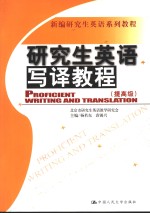

研究生英语写译教程 提高级PDF电子书下载
- 电子书积分:13 积分如何计算积分?
- 作 者:杨若东,袁锡兴主编;北京市研究生英语教学研究会编
- 出 版 社:北京:中国人民大学出版社
- 出版年份:2004
- ISBN:7300059686
- 页数:365 页
CONTENTS 2
Proficient Writing 写作篇 2
Part Ⅰ General Introduction 2
Chapter One What Is Good Writing 2
Part Ⅱ Building Good Sentences 4
Chapter Two Essential Qualities of Sentences 4
Section 1 The Uses of Sentences 5
Section 2 Some Basic Qualities of Sentences 6
Chapter Three Producing Effective Sentences 28
Section 1 Working on Readability 29
Section 2 Manipulating Syntactic Structures for Sentence Coherence 35
Section 3 Emphasizing Main Ideas 52
Section 4 Being Concise 68
Section 5 Achieving Variety 80
Chapter Four Essential Qualities of Paragraphs 91
Part Ⅲ Composing Peerless Paragraphs 91
Section 1 Making the Topic Clear 92
Section 2 Maintaining Paragraph Unity 97
Section 3 Achieving Paragraph Coherence 108
Chapter Five Developing Effective Paragraphs 131
Section 1 Developing the Paragraph Fully 131
Section 2 Choosing a Pattern of Development 134
Section 1 Opening an Essay 145
Chapter Six Writing Special Paragraphs 145
Part Ⅳ Constructing Strong Essays 145
Section 2 Closing an Essay 151
Section 3 Using Transitional Paragraphs 157
Chapter Seven Convincing the Audience 158
Section 1 Adopting a Reasonable Tone 159
Section 2 Selecting an Appropriate Style 162
Section 3 Making Assertions Believable 167
Section 4 Supporting the Assertions 170
Section 5 Reasoning Effectively 172
Part Ⅴ Taking Advantage of Punctuations 177
Chapter Eight The Functions of Punctuations 177
Section 1 The Exclamation Point ! 179
Section 2 The Comma , 181
Section 3 The Semicolon ; 192
Section 4 The Colon : 200
Section 5 Brackets [ ] 203
Section 6 Parentheses ( ) 204
Section 7 The Dash — 205
Section 8 Quotation Marks “ ”and ‘ ’ 207
Section 9 The Ellipsis Mark 209
Proficient Translation 翻译篇 212
第一章 词语的翻译 212
一、词义的选择 212
(二)根据感情色彩选择词义 213
(一)根据词类及搭配选择词义 213
(三)根据文化背景知识选择词义 215
(四)根据上下文和逻辑选择词义 215
(五)根据语气强弱选择词义 217
二、词类的转换 217
(一)英译汉中的词类转换 218
(二)汉译英中的词类转换 222
(一)增词译法 224
三、增词与省略 224
(二)省略译法 228
四、四字词组的翻译 232
(一)英译汉中汉语四字格的使用 232
(二)汉语四字格的英译技巧 234
五、直译与意译(异化与归化) 238
(一)直译与意译的灵活运用 238
(二)谚语、习语的翻译 240
(一)英译汉主语的确立 246
第二章 句子的翻译 246
一、主语的翻译 246
(二)汉译英主语的确立 249
二、定语的翻译 252
(一)英译汉定语的位置及翻译 252
(二)汉译英定语的位置及翻译 254
三、状语的翻译 256
(一)英译汉状语的位置及翻译 256
(二)汉译英状语的位置及翻译 259
四、被动语态的翻译 261
(一)英译汉被动结构的翻译 261
(二)汉译英被动结构的翻译 263
五、正反互译 266
(一)英译汉正反互译的处理 266
(二)汉译英正反互译的处理 269
(一)形象再现 271
六、修辞重现 271
(二)移就 273
(三)杜撰词 275
第三章 篇章的翻译 279
一、照应 279
(一)人称照应 279
(二)指示照应 280
(三)比较照应 281
(四)汉译英照应手段的使用 282
二、衔接 284
(一)语法衔接 284
(二)词汇衔接 285
(三)汉译英词汇衔接手段的实现 286
三、以段落为语篇翻译的基础 291
四、“入乡随俗”准确再现语域风格 293
(一)转换模式 295
五、“洋为中用”适时转换语篇模式 295
(二)编译文本 296
第四章 长句的翻译 299
一、长句的翻译方法 299
(一)英译汉长句的翻译方法 299
(二)汉译英长句的翻译方法 302
二、名词性从句的翻译 306
(一)英译汉名词性从句的处理 306
(二)汉译英复句的处理 309
三、定语从句的翻译 310
(一)英译汉定语从句的翻译 310
(二)定语从句的转换 312
四、状语从句的翻译 315
(一)英译汉状语从句的翻译 315
(三)汉译英偏正复句的处理 316
(二)英译汉状语从句的转换 316
第五章 不同文体的翻译 320
一、法律文件的翻译 320
二、文学的翻译 322
三、旅游材料的翻译 331
四、新闻报道的翻译 334
(一)标题的翻译 335
(二)导语和正文的翻译 336
五、会话的翻译 338
六、论文摘要的翻译 341
(一)摘要的写作要求 341
(二)摘要的写作方法 341
七、应用文的翻译 342
(一)商贸函电的翻译 342
(二)出国留学信函的翻译 351
(三)商业广告及说明书的翻译 360
八、有中国特色的文章的翻译 362
- 《红色旅游的社会效应研究》吴春焕著 2019
- 《高级英语阅读与听说教程》刘秀梅编著 2019
- 《汉语词汇知识与习得研究》邢红兵主编 2019
- 《生物质甘油共气化制氢基础研究》赵丽霞 2019
- 《思维导图 超好用英语单词书》(中国)王若琳 2019
- 《东北民歌文化研究及艺术探析》(中国)杨清波 2019
- 《联吡啶基钌光敏染料的结构与性能的理论研究》李明霞 2019
- 《异质性条件下技术创新最优市场结构研究 以中国高技术产业为例》千慧雄 2019
- 《《国语》和《战国策》词汇比较研究》陈长书著 2017
- 《中国制造业绿色供应链发展研究报告》中国电子信息产业发展研究院 2019
- 《大学计算机实验指导及习题解答》曹成志,宋长龙 2019
- 《中国当代乡土小说文库 本乡本土》(中国)刘玉堂 2019
- 《异质性条件下技术创新最优市场结构研究 以中国高技术产业为例》千慧雄 2019
- 《中国铁路人 第三届现实主义网络文学征文大赛一等奖》恒传录著 2019
- 《莼江曲谱 2 中国昆曲博物馆藏稀见昆剧手抄曲谱汇编之一》郭腊梅主编;孙伊婷副主编;孙文明,孙伊婷编委;中国昆曲博物馆编 2018
- 《中国制造业绿色供应链发展研究报告》中国电子信息产业发展研究院 2019
- 《中国陈设艺术史》赵囡囡著 2019
- 《指向核心素养 北京十一学校名师教学设计 英语 七年级 上 配人教版》周志英总主编 2019
- 《《走近科学》精选丛书 中国UFO悬案调查》郭之文 2019
- 《大学生心理健康与人生发展》王琳责任编辑;(中国)肖宇 2019
